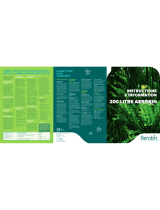
4 Occupant Engagement Program: 2021 Campaign
COMPOST AT HOME
Composting in your backyard can
be a rewarding experience, allowing
you to recycle yard and food waste.
• Select a bin and a site to place it on. At
the bottom of the bin, arrange a six inch
layer of brown material. This layer helps
to bring airflow to your compost pile.
• After the base is formed, you can begin
using your compost pile as intended,
alternating between layers of green and
brown material. The pile will shrink as it
decomposes.
• Monitor your pile and watch for signs
of unpleasant odours or the pile not
shrinking, both of which indicate that
there may be some troubleshooting
required. Water your pile as needed,
keeping it moist but not wet.
• Once your bin reaches full capacity or
2-3 months have passed, check the
bottom of the bin to see if your compost
is ready for harvest.
Setting up a composting station
indoors or on a balcony can be a
good solution for smaller spaces.
• Select an indoor compost bin and
where you would like to place it. Start
by adding a moist layer of brown
matter and a cup of sprinkled soil
on top. Instead of yard waste as
brown matter, you can try shredded
newspaper, cardboard, and dead
leaves. Create a stash of shredded
newspaper to have on hand.
• Add food scraps as needed. Throw a
handful or two of shredded newspaper
every time you add food scraps, as this
helps to reduce excess moisture.
• Once a week, turn your bins contents
with a shovel or by rolling it on its side.
Depending on your home’s ambient
temperature, check your compost
in 2-3 weeks to see if it is ready for
harvest.












